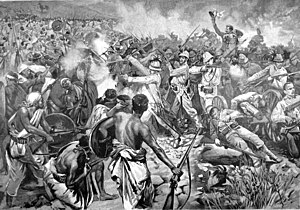Battle of Adua
| date | March 1, 1896 |
|---|---|
| place | Adua , Ethiopia |
| output | Victory of the Ethiopians |
| Parties to the conflict | |
|---|---|
| Commander | |
|
Oreste Baratieri |
|
| Troop strength | |
| more than 60,000; 42 cannons, machine guns, cavalry; 20,000 were armed only with spears | 14,527, 56 cannons (according to other information more than 18,000 men) |
| losses | |
|
10,000 |
more than 11,000 (including 3,000 prisoners and wounded), only 2,500 soldiers escaped |
Halai - Coatit - Senafe - Debra Ailà - Amba Alagi - Mek'elē - Adua
In the Battle of Adua ( Amharic አድዋ , Adowa , also Adwa ) on March 1, 1896, the Ethiopian army under Emperor ( Negus Negest ) Menelik II fought against invading troops from the Kingdom of Italy under General Baratieri near the city of Adua in northern Ethiopia . It was the most important battle of the Italo-Ethiopian War and secured Ethiopian sovereignty.
prehistory
As early as 1887, Italian troops had suffered a severe defeat against Abyssinian troops in the Battle of Dogali . Italy interpreted the Abyssinian-Italian peace treaty concluded by Uccialli in 1889 as a protectorate treaty. Another war broke out, in which the Italians suffered another defeat at the Battle of the Amba Alagi in 1895 .
On February 21, 1896, the commander of the Italian troops, Baratieri, had been replaced by the Italian government. His successor, General Antonio Baldissera, embarked on February 23 in Brindisi for Massaua . In the meantime, Baratieri decided to approach the Abyssinian camp near Adua with his troops in order to occupy favorable terrain there.
One of the reasons for the success of the Ethiopians was that in 1889 Italy itself had supplied Menelik with thousands of modern rifles for the fight against the Mahdists invading from Sudan and against British-Egyptian claims. Ethiopia's own weapons production, promoted by Alfred Ilg, also played a role.
Course of the battle
At 9:00 p.m. on February 29, the Italians began this limited advance in four places, but some of their formations got lost during the night. When they were discovered by the Ethiopians the next morning, the Italian leadership no longer had a complete picture of the situation, while isolated Italian formations were gradually being defeated by the enemy.
consequences
Three thousand Italian prisoners were only released after Ethiopia's full independence was recognized. The province of Eritrea officially became Italian property. The Italian expansion efforts were thus prevented for the next 40 years. Ethiopia remained (alongside Liberia , which was a US colony from 1817 to 1847, and Morocco , which became a French protectorate in 1912), the only African state that was not under colonial rule (until 1922, when Egypt was at least formally independent again) . Adua thus became a defeat on behalf of other colonial powers in Africa. On the other hand, Ethiopia's Emperor Menelik II had to secure the backing of the great powers France and Russia rivaling Italy for his resistance against Italy.
In Europe - at the height of the "age of imperialism " - the victory of the troops of an African country over the army of a European colonial power met with a great response. The defeat led to a serious government crisis in Italy and the overthrow of Prime Minister Francesco Crispi .
The dictator Mussolini used the desire of many Italians for “revenge for Adua” as a propaganda instrument for the moral mobilization of the population before and during his attack on the Abyssinian Empire ( Italian-Ethiopian War (1935-1936) ). After the defeat, Ethiopia was part of the Italian colony of Italian East Africa until the liberation in 1941 .
Victory day of the Battle of Adua is still an Ethiopian holiday today.
literature
in order of appearance
- Ferdinand Siebert : Adua, a turning point in Italian and European politics . In: Historische Zeitschrift , Vol. 181, H. 3 (1956), pp. 533-579.
- Thea Büttner, Heinrich Loth , Christian Mährdel: History of Africa. From the beginning to the present. Part 2: Heinrich Loth: Africa under imperialist colonial rule and the formation of anti-colonial forces 1884–1945. Akademie-Verlag, Berlin 1976, p. 25.
- Bruce Vandervort: Wars of Imperial Conquest in Africa, 1830-1914 (= Warfare and History ). UCL Press, London 1998, ISBN 1-85728-487-9 .
- Giulia Brogini Künzi: The victory of the Negus: Adua, March 1, 1896 . In: Stig Förster, Markus Pöhlmann, Dierk Walter (ed.): Battles of world history. From Salamis to Sinai . CH Beck, Munich 2001, ISBN 3-406-48097-7 , pp. 248-263.
- Ralf Höller: Menelik II of Ethiopia. In: Ralf Höller: I am the fight. Rebels and revolutionaries from six centuries (= construction paperbacks 8054). Aufbau-Taschenbuch-Verlag, Berlin 2001, ISBN 3-7466-8054-9 , p. 222 ff.
- Sean McLachlan: Armies of the Adowa Campaign 1896 - The Italian Disaster in Ethiopia (= Men-at-Arms • 471). Osprey, 2011, ISBN 978-1-84908-457-4 .
- Raymond Jonas: The Battle of Adwa: African Victory in the Age of Empire . Belknap, 2011, ISBN 978-0-674-05274-1 . Reprint : Belknap, 2015, ISBN 978-0-674-50384-7 .
